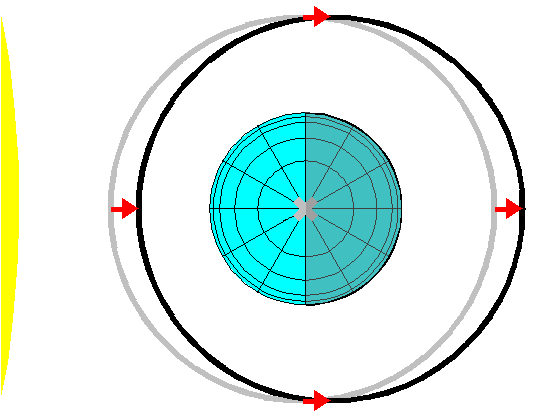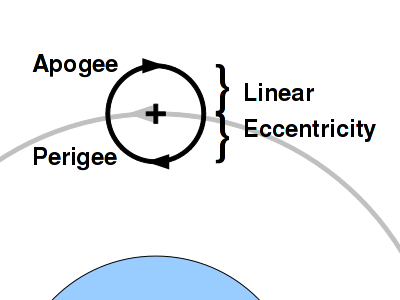|
Size: 4221
Comment:
|
Size: 4220
Comment:
|
| Deletions are marked like this. | Additions are marked like this. |
| Line 6: | Line 6: |
| ||{{attachment:orbit-circle.png|orbit circle|height=200px}}|| An orbit can be viewed in a rotating frame of reference centered on a point in circular orbit. For small eccentricities, an elliptical orbit traces a circle in this frame, rotating in the opposite direction from the orbit itself. That is, if the orbit is eastwards, rotating counterclockwise when viewed from the north, the orbit rotates clockwise in the rotating frame. If the frame is positioned with the earth below, the top of the circle is the apogee and the bottom of the circle is the perigee, so the orbit moves backwards (to the right) compared to the "circular center" at apogee (more slowly), and forwards (to the left) at perigee (more rapidly).<<BR>><<BR>>An elliptical orbit is distorted from a circular one by the distance between the focii of the ellipse. The distance from the center to each focus, or the eccentricity times the semimajor axis, is called the ''linear eccentricity'' of the ellipse, or $ \epsilon r_0 $. The linear eccentricity is the radius of the orbit circle in the rotating frame. || | ||{{attachment:orbitcircle.png|orbit circle|height=200px}}|| An orbit can be viewed in a rotating frame of reference centered on a point in circular orbit. For small eccentricities, an elliptical orbit traces a circle in this frame, rotating in the opposite direction from the orbit itself. That is, if the orbit is eastwards, rotating counterclockwise when viewed from the north, the orbit rotates clockwise in the rotating frame. If the frame is positioned with the earth below, the top of the circle is the apogee and the bottom of the circle is the perigee, so the orbit moves backwards (to the right) compared to the "circular center" at apogee (more slowly), and forwards (to the left) at perigee (more rapidly).<<BR>><<BR>>An elliptical orbit is distorted from a circular one by the distance between the focii of the ellipse. The distance from the center to each focus, or the eccentricity times the semimajor axis, is called the ''linear eccentricity'' of the ellipse, or $ \epsilon r_0 $. The linear eccentricity is the radius of the orbit circle in the rotating frame. || |
Light Pressure Modified Orbits
|
Solar light pressure is useful for maneuvering, but it distorts orbits. Light pressure slows objects orbiting towards the sun, and speeds up objects orbiting away from it. This raises and lowers portions of the orbit. A slightly elliptical orbit with perigee towards the sun will rotate. With proper matching of eccentricity, the apogee and perigee will complete one rotation per year. |
|
An orbit can be viewed in a rotating frame of reference centered on a point in circular orbit. For small eccentricities, an elliptical orbit traces a circle in this frame, rotating in the opposite direction from the orbit itself. That is, if the orbit is eastwards, rotating counterclockwise when viewed from the north, the orbit rotates clockwise in the rotating frame. If the frame is positioned with the earth below, the top of the circle is the apogee and the bottom of the circle is the perigee, so the orbit moves backwards (to the right) compared to the "circular center" at apogee (more slowly), and forwards (to the left) at perigee (more rapidly). |
If the orbit precesses once per year, then the vector of the linear eccentricity makes one complete rotation per year. Each orbit adds a little bit of rotation to that vector.
Viewed closely, the displacement caused by light pressure looks like a cycloid ruffle on the orbit circle. In the rotating frame of reference, the sun appears to rotate around the orbit circle once per orbit period, with the light pressure acceleration pointing away from the sun. The sun "disappears" during the eclipsed part of the orbit, and this changes the math somewhat, but the major effects are caused when the object is moving towards or away from the sun, on the sides of the ellipse. This rough estimate ignores eclipses.
Referenced to a zero angle at apogee, the light pressure acceleration in the x direction is a_x = a_L sin( \omega t ) and a_y = a_L cos( \omega t ) . a_L is approximately 17 \mu m / s ^ 2 for a 100 micron thick server-sat. Assuming we start at zero position and velocity, then doubly integrating each of these equations results in x = ( a_L / \omega^2 ) ( \omega t - sin ( \omega t ) ) and y = ( a_L / \omega^2 ) ( 1 - cos ( \omega t ) ) . This is the formula for a cycloid. After one orbit period P ( \omega = 2 \pi / P ) x has shifted by a_0 P^2 / 2 \pi . The sum of these increments add up to the orbit circle over one year Y, so x Y / P = 2 \pi \epsilon r_0 . Solving for the linear eccentricity, \epsilon r_0 = ( a_L P Y )/( (2 \pi)^2 . For a_L = 17 \mu m / s ^ 2 and the m288 orbit ( P = 4*3600 = 14400 seconds ), this is around 200 km.
Lighter server-sats will have higher light pressure acceleration, and orbit with larger linear eccentricities. This will result in larger relative displacements. Regions of m288 with higher and lower server-sat area-to-mass ratios should be separated by hundreds or thousands of kilometers.
Perhaps the m360 and m480 orbits should be reserved for lighter and lighter server-sats, assuming that the trend over time will be towards lighter server-sats, better boosters, and more sophisticated latency management. Solar power arrays at lunar distances will be very light, but will have a lot more room for linear eccentricity displacements.


